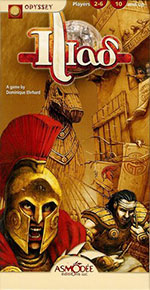by Demian Katz
 Iliad (2006)
Iliad (2006)
Published by Asmodee Editions LLC
Designed by Dominique Ehrhard
English translation by Nathan Morse
Illustrated by John MacCambridge
Contents: 3 victory tiles, 110 cards (21 Victory cards, 6 Hero cards, 8 Oracle cards, 75 Army cards), rules, 2 summary sheets
2-6 players
$21.99
Iliad translates the siege of Troy into a card game suitable
for play by a fairly wide range of group sizes. While some of the rules
vary along the spectrum between the slightly stripped-down two-player
version and the team-oriented six-player version, the game always
manages to deliver an interesting strategic challenge using extremely
simple mechanics.
Gameplay
Each player starts the game with a hand of twelve cards representing
elements of his or her army: archers, hoplites, chariots, etc. Each
turn, the player is offered a simple choice: play a card from the hand
to the table, or use a card already on the table to eliminate an enemy
card. Combat is always mutually destructive: attacking an enemy unit
always results in both attacker and defender being eliminated. Combat
is also limited by the fact that each type of unit is only allowed to
attack a limited set of targets; you can't eliminate a catapult with an
archer! Units aren't just there to kill each other, though. The point
of the game is to build the strongest besieging army, and most cards
have a point value which contributes to the overall strength of their
owner's army. In many cases, cards can be combined in interesting ways:
putting archers on the backs of elephants makes them stronger and more
valuable; hiding troops in a Trojan horse can protect them and add an
element of bluff to the game; combining hoplites into a phalanx offers
significant score multipliers. Winning a siege involves playing cards
in the most effective order and finding ways to kill your enemies' most
valuable units while defending your own long enough to see the end of
the fighting.
Of course, there's more to the game than winning a single battle
– players must fight through a whole series of conflicts before
the overall winner is declared. There are two different ways that each
siege can be carried out, and the method for each one is determined by
drawing an Oracle card. Oracle cards may show a Gorgon, in which case
the siege proceeds until a single player is stronger than all opponents
at the start of his or her turn – a sort of sudden death round; or
they may show Thanatos, which leads to a battle of attrition in which
the fighting continues until all players have decided to drop out.
During a Thanatos round, dropping out early gives you access to a better
hero for your army but leaves you open to attack for a longer period of
time; in a Gorgon round, dropping out nearly assures your failure but at
least helps you save valuable cards. Cards are a precious resource
since, while players start the game with 12, they only recover 4 new
ones at the end of each siege. Managing these resources is an important
part of play, as it is easy to burn out early if you spend your forces
unwisely!
Regardless of the type of siege fought, when the battle is over, the
winning player has the first pick of victory cards (showing objectives
like cities, triremes and Helen herself) and, in the case of a Thanatos
round, the losing player earns a penalty card. The ultimate objective
of the game is to either earn 12 victory points or to have the most
victory points when the Oracle deck runs out. Victory points come from
victory cards (all of which are worth between 1 and 5 points) and from
bonus tiles earned by winning battles or holding majorities in cities or
triremes. The fact that tiles change hands frequently throughout play
adds a fluidity to the scoring and increases the importance of
strategically acquiring the right victory cards at the right times.
Presentation
Iliad is packaged in a slim, efficient box and contains
good-quality components: coated playing cards, thick cardboard tiles and
full-color instructions. The product is heavily illustrated with
paintings that, while not outstandingly stylish, are certainly
professionally executed. Icons are used effectively on the cards to
summarize their characteristics, and the summary cheat sheets help with
most of the other details... though there are still a few minor details
that you need to remember from the rulebook! While this isn't the sort
of game that you pull down off the shelf just to gaze at its beauty,
you're not likely to have any complaints about the way it has been put
together – all the parts get the job done.
Conclusions
For the card game fan, there is a lot to like about Iliad: it
supports several different group sizes; it offers a good amount of
variety both in the types of cards available to be played and through
the two different types of sieges that come up during play; and it
involves deep, long-term strategy and resource management without
introducing overly complicated rules. If you're looking for something
just a little deeper than the average abstract Euro card game but still
significantly lighter than the typical CCG, this is a good fit. There's
a lot going on here, so you won't tire of it too quickly, but it's still
simple enough to pull out on short notice and play through in well under
an hour. This will definitely be hitting my table again soon!
Links:
| Other Asmodee game reviews on OgreCave: |
|
|


 Iliad (2006)
Iliad (2006)